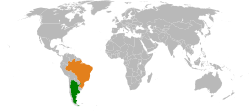Argentina-Brazil relations
 |
|
|
Argentina |
Brazil |
|---|---|
Relations between the Argentine Republic and the Federative Republic of Brazil are both close and historical, and encompasses all possible dimensions: economy, trade, culture, education and tourism. From war and rivalry to friendship and alliance, this complex relationship has spanned more than two centuries.
After achieving independence from the Iberian crowns in the early nineteenth century, Argentina and Brazil inherited a series of unresolved territorial disputes from their colonial powers. The most serious breach in the relationship was the Cisplatine War (1825–1828), led by the Brazilian invasion and annexation of the Banda Oriental. Despite the numerous periods of muted hostility, the Argentine–Brazilian relationship was not defined by open hostility for most of the nineteenth and twentieth centuries. There was competition on many levels, and their respective defense policies reflected mutual suspicion, but the Brazilian economic rise in the 1980s led to the accommodation of Argentina as a secondary regional power and increasing cooperation.
With the creation of the Brazilian–Argentine Agency for Accounting and Control of Nuclear Materials in 1991, the two countries turned their nuclear competition into cooperation through mutual confidence. A high volume of trade and migration between Argentina and Brazil has generated closer ties, especially after the implementation of Mercosur in 1991. Today, the strategic relationship between Argentina and Brazil is considered to be "at the highest point in history". Argentine foreign policy has given special emphasis in "deepening the strategic alliance with Brazil in all its aspects". Likewise, Argentina has been "an absolute priority" for Brazilian foreign policy.
Argentina and Brazil are neighbouring countries of South America, and two of the most important economies in South America. The two countries combined represent 63% of the total area of South America, 60% of its population and 61% of its GDP.
...
Wikipedia
